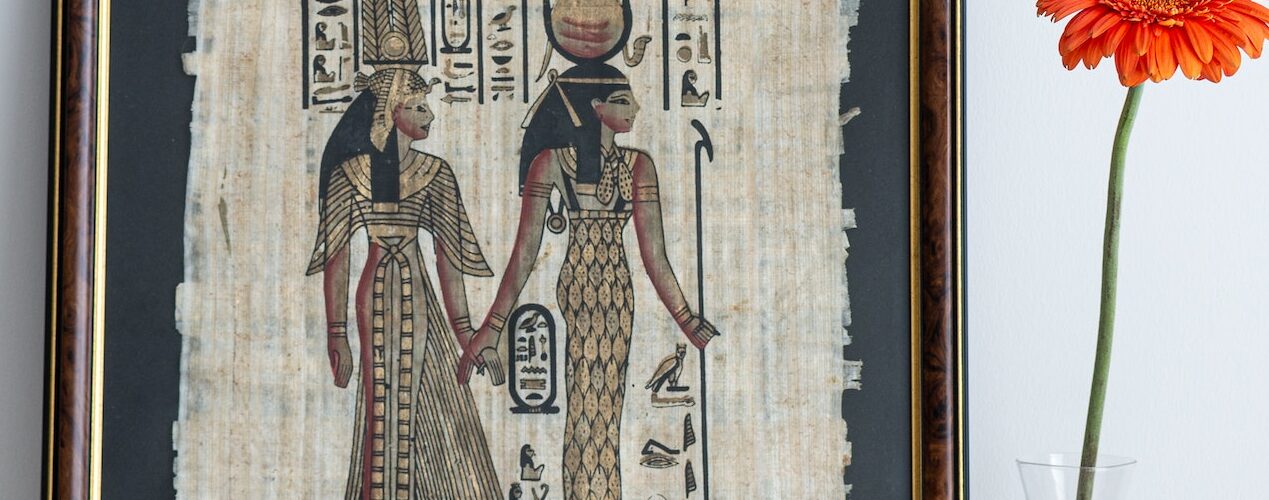One reason we can know about ancient Egypt is because of pieces of information written on a brownish material, which is commonly known as Papyrus.
Papyrus is the world’s earliest example of paper, made from reeds in the river Nile. It has been suggested that the English word we use today for writing material, i.e., “paper,” is etymologically derived from papyrus, and its history dates back many centuries ago closely associated with the ancient Egyptians.
The use of papyrus dates back to at least the 3rd millennium BCE in ancient Egypt, as it became the primary writing material for the people in the region.
About Papyrus
Papyrus paper or other items is made from the papyrus plant (Cyperus papyrus), which grows abundantly in the marshy regions of the Nile Delta and the low-lying areas fringing the Nile Valley in Egypt.
While we know Papyrus is commonly known for producing paper, the plant is also used to make baskets, sandals, ropes, mats, and other items. Probably, that is why it has a rich connection and symbolism in the history of ancient Egypt.
The plant canopy resembles the sun’s rays, reminiscent of the Sun God Amun-Ra, and the sliced-off bottom part of the stem corresponds to a Pyramid.
Papyrus plants are displayed in many religious and historical paintings drawn or engraved on Egyptian temples, tombs, and buildings. In one of the prominent engravings that shows the unification of Upper and Lower Egypt, we can find Papyrus plants (associated with the Delta of Lower Egypt) bound with a lotus or lily flowers (the symbol of Upper Egypt).
Papyrus Papermaking
To use Papyrus for making papers, harvesters cut the mature stems of the plant at the base, leaving the roots intact so that the plant can regrow.
Post which, the outer greener layer of the stems is sliced off to expose the inner whiter core. The stem’s pith (inner core) is cut into thin strips, usually around 3-4 mm wide, and then flattened using a wooden roller or hammer to squeeze out the water content. The flattened piece is soaked in water, which helps reduce the natural sugar content and darken the stem. The longer it stays in the water, the darker it becomes.
After a few days of soaking (3 to 7 days, depending on how much darker shade one wants), the sticky narrow strips are taken from the water and laid horizontally and vertically in a crisscross to form a square or a rectangle sheet. These sheets were pressed under a heavy object (stones in ancient times) for a few more days (~7 days) and dried to create a writing surface.
The interesting aspect of the papyrus papermaking process does not involve any chemicals or glues, which is also a reason for its longevity.
Significance of Papyrus Papers in Egypt
Egypt’s hot, dry climate, particularly in desert regions, and innate compounds were crucial in preserving organic materials like papyrus. Buried papyrus scrolls were protected from decay and destruction, allowing them to survive for thousands of years until modern archaeologists unearthed them.
In the early 19th century, archaeologists began uncovering ancient Egyptian sites, including burial sites, tombs, and temples, where they found numerous well-preserved papyrus scrolls. These discoveries significantly contributed to our understanding of ancient Egypt’s history, beliefs, customs, language, and practices.
The first evidence of papyrus being used for writing comes from the Pyramid Texts, religious texts found in the pyramids of the Old Kingdom (circa 2686–2181 BCE).
When individuals of high social status or religious importance died, they were often buried with Papyrus scrolls. The papyrus of Yuya, one of the ancient nobles, found in the corridor of his tomb, is more than 60 feet long, consists of 35 papyrus sheets, and contains the “Book of the Dead.”

An extract from the information mentioned on the board displayed about the “Papyrus of Yuya” in the Cairo Museum.
The papyrus contains the Book of the Dead, written in cursive hieroglyphs with colored and highly detailed vignettes. The Book of the Dead, whose ancient designation was The Book of Going Forth by Day, is a collection of recitations, spells, warnings, threats, guides, and confessions, among other compositions, rather than a true “Book.”
In this cursive papyrus, the texts running from left to right the papyrus begins on the left side, which is the East. The spells of this papyrus are gathered in standard sequences. The papyrus starts and ends with standard sequences: the worship of Osiris, the funeral procession, and the set of spells expounding identity with creation and securing justification at the tribunals of deities, and at the end, spells for access to the solar circuit and for passing by the underworld mounds.
The use of papyrus facilitated the spread of knowledge throughout ancient Egypt. The paper was used to create ancient Egyptian paintings, temple drawings, manuscripts, art, and Arabic typography. In addition, papyrus paper was also utilized for various business and economic activities, including documenting trade transactions, legal records, literature, and administrative documents.
Over time, the knowledge of papyrus-making spread to other civilizations in the Mediterranean region. The ancient Greeks and Romans also adopted papyrus as writing material, importing it from Egypt or producing it in areas with similar environmental conditions.
Papyrus Papers in Current Times
The production and use of papyrus continued for centuries. However, with the decline of ancient Egyptian culture, papyrus gradually lost its prominence as a writing material as paper (made from wood pulp) became more widely used.
Today, papyrus is no longer used as everyday writing material. Still, it has become a symbol of ancient Egyptian civilization and a reminder of the importance of writing and record-keeping in human history. Many ancient papyrus scrolls are preserved and displayed in museums worldwide, giving us a glimpse into this ancient civilization’s rich and fascinating history.
Papyrus plants are still grown in some regions, and artisans produce papyrus sheets for decorative and artistic purposes, catering to the interests of tourists and history enthusiasts—a range of souvenirs made of papyrus, from small postcards to beautiful works of art.
The production of authentic papyrus can be seen at the Papyrus Institute of Aswan, Cairo, and Luxor and also in some shops in Egypt.
Wrapping Up
The papyrus-making process was invented thousands of years ago, after which it disappeared for centuries until rediscovered again by Egyptologists and archeologists through ancient Egyptian paintings, temple drawings, and manuscripts.
Not sure if the history of Papyrus paper will inspire us to restart this sustainable practice, but it will remain an essential milestone in human communication and information preservation history.
For a visual representation of the history and significance of Papyrus Paper, you can watch this video, available on the Change Started YouTube channel.






Add comment